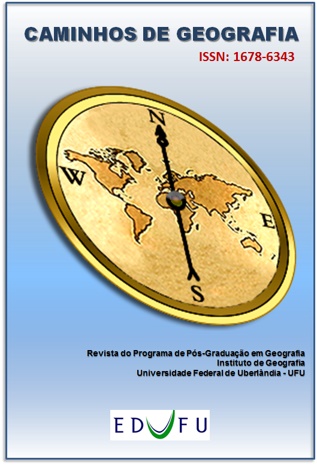POTENCIALIDADES E LIMITAÇÕES DO USO DE INFORMAÇÕES ALTIMÉTRICAS PROVENIENTES DE PERFILAMENTO À LASER EM AMBIENTE URBANO
DOI:
https://doi.org/10.14393/RCG228457243Palavras-chave:
Modelo Digital de Elevação (MDE), LIDAR, Índice Topográfico de Umidade (ITU), Área UrbanaResumo
A concentração da população brasileira residindo em ambientes urbanos demandam uma gestão eficiente do território e dos efeitos provenientes do escoamento hídrico, tais como erosão, inundações e movimento de massa. O presente trabalho tem como objetivo adequar para áreas urbanas a delimitação de Áreas de Sensibilidade Hidrológicas (ASH), utilizando o Índice Topográfico de Umidade (ITU). A área de estudo é a Região Administrativa de São Sebastião do Distrito Federal que apresenta expansão urbana recente e problemas de drenagem urbana. A pesquisa discute as potencialidades e limitações quanto à utilização de dados altimétricos provenientes de laser na derivação de Modelos Digitais de Elevação (MDE) e na estimativa do escoamento superficial. A aplicação do índice HSA em áreas urbanas necessita de metodologias específicas: redução da nuvem de pontos amostrais pela seleção de fatores relevantes para o fluxo da água, filtragem de artefatos, manutenção das feições urbanas que condicionam o direcionamento hídrico, eliminação da cobertura vegetal, dentre outros. Os resultados obtidos mostram o potencial de estabelecer áreas sensíveis dentro da rede urbana com alta precisão, considerando as influências da topografia local. Portanto, a pesquisa inova ao apresentar uma solução metodológica de estimativa de HSA para o ambiente urbano na escala local.
Downloads
Downloads
Publicado
Edição
Seção
Licença
Copyright (c) 2021 Felipe Lima Ramos Barbosa, Erondina Azevedo de Lima, Renato Fontes Guimarães, Osmar Abílio de Carvalho Júnior, Roberto Arnaldo Trancoso Gomes

Este trabalho está licenciado sob uma licença Creative Commons Attribution-NonCommercial-NoDerivatives 4.0 International License.
Autores que publicam nesta revista concordam com os seguintes termos: a) Autores mantém os direitos autorais e concedem à revista o direito de primeira publicação, com o trabalho licenciado sob a Creative Commons Atribuição-NãoComercial-SemDerivações 4.0 Internacional. b) Autores têm permissão e são estimulados a publicar e distribuir seu trabalho online (ex.: em repositórios institucionais ou na sua página pessoal), já que isso pode gerar alterações produtivas, bem como aumentar o impacto e a citação do trabalho publicado. c) Em virtude de aparecerem nesta revista de acesso público, os artigos são de uso gratuito, com atribuições próprias, em aplicações educacionais e não-comerciais.











